Monday, July 19th, 2010
Have you ever noticed that spark in a young child’s eye when they’re learning something new? There’s an excitement to their discovery, a satisfaction in learning, something to take pleasure in, a palpable exhilaration. On the flipside, why is it that this spark, this love of learning we so easily recognize in young children, seems to diminish as they progress through school, grade after grade? What is it that we’re doing wrong, learning should be fun right? What should parents and teachers do differently? How can we fan the flame of learning in all children to create passionate, life long learners?
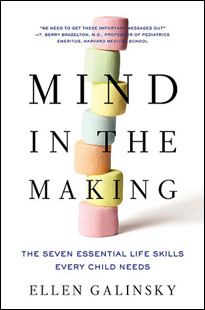 These are just the few of the questions posed to readers in Ellen Galinsky’s new book Mind in the Making: The Seven Essential Life Skills Every Child Needs. Out in the world today there are a lot of behavioral and developmental research studies that clinically describe what’s happening during a child’s growing years. The problem however is that this information often feels inaccessible to everyday moms and dads. What’s great about Ellen’s book Mind in the Making is that it makes the inaccessible accessible. Each chapter is filled with carefully selected and easy to understand research that consistently shines a light on what’s going on with your growing child. Sprinkled throughout these findings are recommendations from the author on how to grow that spark and stories from everyday parents that share similar concerns and their successes related to helping their child thrive.
These are just the few of the questions posed to readers in Ellen Galinsky’s new book Mind in the Making: The Seven Essential Life Skills Every Child Needs. Out in the world today there are a lot of behavioral and developmental research studies that clinically describe what’s happening during a child’s growing years. The problem however is that this information often feels inaccessible to everyday moms and dads. What’s great about Ellen’s book Mind in the Making is that it makes the inaccessible accessible. Each chapter is filled with carefully selected and easy to understand research that consistently shines a light on what’s going on with your growing child. Sprinkled throughout these findings are recommendations from the author on how to grow that spark and stories from everyday parents that share similar concerns and their successes related to helping their child thrive.
Last week I had the pleasure of meeting Ellen at a gathering to discuss her work in New York City’s Teachers College at Columbia University. During the event, Ellen was interviewed onstage by Lisa Guernsey, another fantastic author who wrote the book Into the Minds of Babes: How Screen Time Affects Children from Birth to Age Five (360KID interview with Lisa about her book, video) The pairing of these two authors together for the event was excellent and a video of the conversation can be enjoyed below. During the presentation, Ellen not only shared many of the insights she has written about in her book, she also presented another dimension of her journey through carefully captured video recordings of researchers describing their studies. There are many compelling observations described through these videos for parents to learn about and use in daily interactions with their child. One video in particular is a “must watch” if you are unfamiliar with “The Marshmallow Experiment, †a study that looks at the internal conflict four year old children struggle with when offered one marshmallow they can eat now or instead two marshmallows they can eat later. This experiment is technically referred to as a study in delayed gratification and you can enjoy the discovery of this experiment (as a newly refreshed life long learner through reading Ellen’s book) in the interview below. Enjoy!


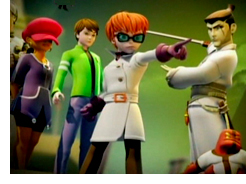
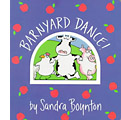 A delightful rhyming story of barnyard friends that go to a dance. The rhythm and meter of this story will keep you reciting sections from this book for days on end. Another great find for our family was discovering that there’s a Sandra Boynton CD available with this book’s lyrics set to song.
A delightful rhyming story of barnyard friends that go to a dance. The rhythm and meter of this story will keep you reciting sections from this book for days on end. Another great find for our family was discovering that there’s a Sandra Boynton CD available with this book’s lyrics set to song.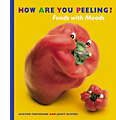 Elffers is a fantastic photographer with a talent for bringing personality and emotion out of common everyday fruits and vegetables. Each page is filled with wonderful facial expressions from his creations. Light copy, lots of unique and interesting faces to enjoy.
Elffers is a fantastic photographer with a talent for bringing personality and emotion out of common everyday fruits and vegetables. Each page is filled with wonderful facial expressions from his creations. Light copy, lots of unique and interesting faces to enjoy.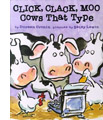 Farmer Brown runs a no-nonsense farm, but things change once the cows who live there acquire an old typewriter and learn how to express there wishes on short notes. When Farmer Brown doesn’t comply with the cows requests, the cows decide they will go on strike. Fun, fun. fun!
Farmer Brown runs a no-nonsense farm, but things change once the cows who live there acquire an old typewriter and learn how to express there wishes on short notes. When Farmer Brown doesn’t comply with the cows requests, the cows decide they will go on strike. Fun, fun. fun!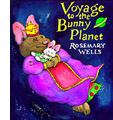 There are so many great books written by Rosemary Wells that it’s hard to pick even just a few, but the Bunny Planet books (a small collection of three books sold together as a set) have a wonderful Zen-like story quality to them. Ms. Wells explores the idea of a perfect world that lives inside our heads when things outside don’t go quite as well as we had planned.
There are so many great books written by Rosemary Wells that it’s hard to pick even just a few, but the Bunny Planet books (a small collection of three books sold together as a set) have a wonderful Zen-like story quality to them. Ms. Wells explores the idea of a perfect world that lives inside our heads when things outside don’t go quite as well as we had planned.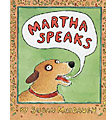 The story of a family dog named Martha who likes to eat alphabet soup. The interesting twist in the story is that when Martha eats the soup, the letters go up to her brain instead of down to her tummy! There are many Martha Speaks books available and the first is the one that sets up the story for the entire series.
The story of a family dog named Martha who likes to eat alphabet soup. The interesting twist in the story is that when Martha eats the soup, the letters go up to her brain instead of down to her tummy! There are many Martha Speaks books available and the first is the one that sets up the story for the entire series.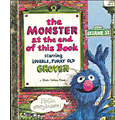 I think everyone in the entire world loves Grover, the fuzzy blue character from Sesame Street. In this story, Grover asks, even begs, the reader not to turn the pages of this book because he’s afraid there’s a monster that might scare him on the very next page. You will read this one again and again with your young child.
I think everyone in the entire world loves Grover, the fuzzy blue character from Sesame Street. In this story, Grover asks, even begs, the reader not to turn the pages of this book because he’s afraid there’s a monster that might scare him on the very next page. You will read this one again and again with your young child.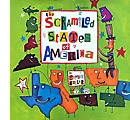 What would happen if each state in the nation could move to a new location? This book explores the fun and mayhem that ensues when each state moves to where they think they would really enjoy living. A funny story for children who are learning to memorize the US states.
What would happen if each state in the nation could move to a new location? This book explores the fun and mayhem that ensues when each state moves to where they think they would really enjoy living. A funny story for children who are learning to memorize the US states.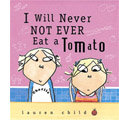 This is the first book that began the popular Charlie and Lola series of books and television shows. Lola is a very finicky eater. Her older brother Charlie presents familiar foods with funny names and stories that make Lola curious about what she might be missing. Just where do peas and fish sticks come from? And what sort of story would you tell to make eating these items more appealing?
This is the first book that began the popular Charlie and Lola series of books and television shows. Lola is a very finicky eater. Her older brother Charlie presents familiar foods with funny names and stories that make Lola curious about what she might be missing. Just where do peas and fish sticks come from? And what sort of story would you tell to make eating these items more appealing? The Owly book series are a charming collection of graphic novels starring an owl and his woodland friends. Together they go on many adventures, making new friends and helping other animals and friendly insects along the way. These books require a parent to imagine and invent the dialog alongside the visuals which I believe fosters an even closer story telling experience between reader and child.
The Owly book series are a charming collection of graphic novels starring an owl and his woodland friends. Together they go on many adventures, making new friends and helping other animals and friendly insects along the way. These books require a parent to imagine and invent the dialog alongside the visuals which I believe fosters an even closer story telling experience between reader and child.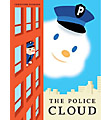 The graphic design approach to this story is just beautiful. Christoph Nieman is an artist for the New Yorker magazine and now shares his visual talents as a children’s book author. Nieman tells a captivating story about a cloud that wishes to become a policeman.
The graphic design approach to this story is just beautiful. Christoph Nieman is an artist for the New Yorker magazine and now shares his visual talents as a children’s book author. Nieman tells a captivating story about a cloud that wishes to become a policeman.
